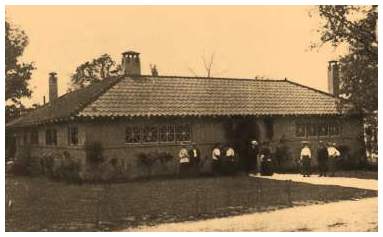Idaho
 | |
| Location | Plateau of States |
|---|---|
| Construction | |
| Construction Cost | $6,964 ($210,029 in 2021) |
| Dates | |
| Dedication Day | May 4, 1904 |
| Architecture | |
| Architect | J. Flood Walker, of Boise City |
| Dimensions | 61' x 61' |
Idaho's state building stood in the western group of state buildings on The Trail, not far from the Boer War attraction.
Description
The one story-high hacienda was designed in a Spanish style, complete, with the inner patio and slate roof. The structure contained ten rooms, arranged on the four sides of the open patio. The roof was of bright red Spanish tiles and the exterior of cream-colored staff.
The narrow windows appear inaccessible, their sills six feet from the earth. In an arched opening swings an iron gate eight feet across that leads into the inner patio. Two great poplars at opposing corners rose twenty feet above the closely cropped grass, and clambering vines covered their naked trunks. Semitropical plants made a central mass of bright color.
The interior finish served to show the utility of Idaho woods for this particular use. Women displays occupied the north side of the building.
A gallery surrounds the court, and at intervals about it are easy chairs of reed and rattan. The rooms open from it. They are finished in the latest color schemes. Great window seats in the gentlemen's and ladies' parlors are fifteen feet long. Indian bows, arrows, tomahawks, belts and baskets, as well as some magnificent blankets, add color and uniqueness. The doors are of single wood slabs and across them pass wide iron openwork hinges which contrast strongly with the woodwork.
Each of the rooms has individuality, but the ladies' parlor on the north side of the building may be taken as a fine type. The walls are in sage brush yellow, the woodwork in sage green, the floor of dark sage green, and the furniture of a darker shade of the same color. At one end is a finely finished Conover piano, while opposite it, between the high Spanish windows, is an artistic mantel with side cabinets. Contrast this with the dining-room, which has a white enamel wainscoting six feet high, light blue walls and ceiling, and mahogany furniture.
Transparencies and mounted photographs illustrated the vast forest resources of the state.
The state showed pleasing exhibits at the Palace of Horticulture as well as promoted its bountiful mineral mineral deposits (particularly opals), at the Palace of Mines. Also shown were: specimens of lead ores from Halley and Wood Rivet district, where lead to the value of 20,000,000 dollars had been taken out. These specimens included some of the Minnie Moore deposits, the most famous mine in Idaho's history, whose best ores showed 70% lead and 110 ounces of silver to the ton. A few specimens of gold-bearing quartz from the Boise basin were shown. Included was gold ores from Shoshone County showed the wide distribution of the yellow metal, which appeared in every county in Idaho.
In the Palace of Agriculture, Idaho exhibited 47 varieties of wheat, 41 varieties of oats, 32 varieties of flax--the only specimen of white flaxseed known to exist, from the farm of Alonzo McWillis, of Rosetta, who received a gold medal for his exhibit.
It was not practicable to show Idaho melons, strawberries, and small fruits in fresh condition, but a display with a showy array of canned fruits and dried fruits of favorite sorts attracted attention. Idaho potatoes of the 5-pound class were a part of the exhibit, along with turnips, carrots, parsnips, onions, and other vegetables.
After the Fair
The building was sold at the close of the Fair to a Texan.
